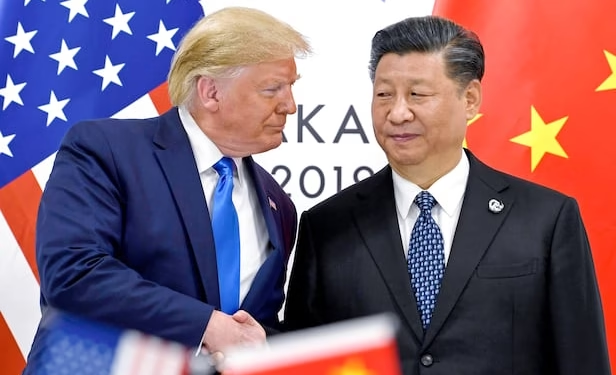US President Donald Trump confirmed he will meet Chinese President Xi Jinping in South Korea within weeks, setting up a critical summit that could determine whether cryptocurrency markets recover from their worst liquidation event on record. The Trump-Xi meeting announcement comes despite Trump’s threat to impose 100% tariffs on Chinese goods starting November 1—a move that sent bitcoin plunging 15% and triggered $18.28 billion in forced liquidations across crypto markets.
The Escalating Trade War: From 10% to 100% Tariffs
The path to this critical summit has been marked by dramatic escalation in US-China trade tensions throughout 2025.
In February 2025, Trump declared a national emergency over Chinese drug-trafficking to justify a 10% tariff on all Chinese imports, which he increased to 20% in March. China retaliated with tariffs of 15% on coal and liquefied natural gas and 10% on oil and agricultural machines.
The situation intensified dramatically in April. On April 2, known as “Liberation Day,” Trump declared a national emergency regarding the national trade deficit and announced “reciprocal tariffs” on all countries, with a minimum 10% tariff on almost all US imports taking effect on April 5.
After a retaliatory spiral, US tariffs on Chinese goods rose to 145% while Chinese tariffs on US goods reached 125%. The two countries agreed in May to lower tariffs after negotiations, with China bringing levies on American exports down to 10% from 125%, and the United States reducing rates to 30% from 145%.
The Rare Earth Crisis
The latest flashpoint emerged in October. China tightened export controls on critical rare-earth metals used to manufacture electronics under its “announcement number 61 of 2025,” including holmium, erbium, thulium, europium, and ytterbium.
Trump retaliated by announcing the United States would impose a new tariff of 100% on imports from China “over and above any Tariff that they are currently paying,” starting November 1, along with export controls on “any and all critical software”.
Around 70% of the global supply of rare earths minerals comes from China, and these minerals are essential for high-tech industries, including automobiles, defense and semiconductors.
China’s Defiant Response
China signaled it would not back down in the face of Trump’s 100% tariff threat, with the Commerce Ministry stating: “China’s stance is consistent. We do not want a tariff war but we are not afraid of one”.
China’s Ministry of Commerce accused the US of “deliberately creating unnecessary misunderstanding and panic,” but indicated it remains open to trade talks to resolve the dispute.
The Chinese Commerce Ministry noted that export licenses would be granted for legitimate civilian uses of rare earths, while acknowledging the minerals also have military applications.
Cryptocurrency Markets Caught in the Crossfire
The trade war has created unprecedented volatility in cryptocurrency markets, with digital assets experiencing some of the most dramatic price swings in recent history.
The Historic October Crash
Trump’s threat to impose an additional 100% tariff on imports from China sparked a massive cryptocurrency sell-off that brought total liquidations to $18.28 billion, marking “the largest liquidation event in crypto history,” according to data analysis platform CoinGlass.
Bitcoin fell from roughly $122,500 to a low of roughly $104,600 on Friday afternoon following Trump’s tariff announcement, a drop of 15% at its lowest point. Ethereum, the world’s second largest cryptocurrency by market value, fell roughly 21%.
Highly speculative assets suffered even worse. Dogecoin dropped more than 50%, while President Trump’s $TRUMP coin fell roughly 63% at its lowest point.
April’s “Liberation Day” Selloff
The April tariff announcements triggered similarly dramatic declines. Bitcoin tumbled to a low of $74,700 following Trump’s deluge of tariffs on Wednesday, wiping out previous post-election gains. The broader crypto market wiped out 9% of its total market cap, falling from $2.72 trillion to $2.47 trillion.
The aggressive crypto selloff was sparked by a risk-off stampede, as nervous investors dumped their riskier bets and fled to the perceived safety of government-issued Treasury bonds and gold.
Institutional Adoption Continues
Despite volatility, structural forces including ETF adoption, institutional inflows and regulatory clarity continue to support long-term growth for Bitcoin.
Trump recently issued an executive order allowing digital assets like crypto to be included in 401(k) plans, causing bitcoin to soar to a record high of $124,000 before the recent tariff-driven selloff.
What’s at Stake in the Trump-Xi Meeting
The upcoming summit carries enormous implications for global markets, including cryptocurrency.
Although it remains uncertain whether the Chinese and U.S. leaders will hold a separate summit in South Korea, a meeting between them within the next year still appears likely, with the disputes witnessed now essentially being tactics and bargaining chips employed by both sides.
Key Issues on the Table
Tariff Stability: While tariff levels are unlikely to return to pre-2025 levels, a higher yet stable arrangement could bring much-needed predictability to both economies and global markets.
Rare Earth Access: For the United States, a critical part of trade agreements has been to ensure China will increase its supply of rare earth magnets, essential for defense applications and consumer electronics.
Port Fees: Both countries have imposed port fees on each other’s ships, with China’s fees on American ships taking effect and the US implementing similar measures on Chinese vessels.
What China Wants
American colleagues often ask what China hopes to achieve in a summit: a tariff deal, eased high-tech restrictions, or something else. U.S. policymakers tend to focus on specific, concrete issues, while their Chinese counterparts emphasize the broader framework—a structure within which the bilateral relationship can remain stable and manageable.
Beyond presidential engagement, Beijing hopes to revive regular exchanges among government departments under high-level guidance, with diplomatic, military, and economic teams resuming frequent dialogues to address concrete issues.
Economic Impact: By the Numbers
The scale of Trump’s tariff regime represents a dramatic shift in U.S. trade policy.
During Trump’s second term from January to April 2025, the average applied US tariff rate rose from 2.5% to an estimated 27%—the highest level in over a century. By September 2025, US tariff revenue exceeded $30 billion per month, compared to under $10 billion per month in 2024.
In 2025, Trump’s imposed and scheduled tariffs will increase federal tax revenues by $174.9 billion, or 0.57 percent of GDP, making the tariffs the largest tax hike since 1993.
Economic Consequences
Using the Tax Foundation’s General Equilibrium Model, economists estimate the Trump-Biden Section 301 and Section 232 tariffs will reduce long-run GDP by 0.2 percent, the capital stock by 0.1 percent, and hours worked by 142,000 full-time equivalent jobs.
What Crypto Investors Should Watch
As the Trump-Xi meeting approaches, several factors will be critical for cryptocurrency markets:
- Meeting Outcomes: Any agreement to stabilize tariff levels could reduce volatility and restore investor confidence in risk assets like crypto.
- Dollar Strength: Continued dollar weakness could drive more investors toward Bitcoin as an alternative store of value.
- Fed Policy Response: If tariffs weigh on GDP without triggering a fresh inflation spike, the Fed may have scope to cut rates—reintroducing the liquidity conditions under which Bitcoin has historically excelled.
- Regulatory Clarity: Trump’s pro-crypto stance and regulatory reforms continue to provide long-term support for the industry despite trade war turbulence.
- Global Liquidity: Traditional safe havens like gold reaching record highs often precede Bitcoin rallies as capital rotates into alternative assets.
Expert Predictions: Where Bitcoin Goes From Here
Grayscale’s Zach Pandl believes that bitcoin will hit new all-time highs this year, despite current pessimism around prices, stating: “I wouldn’t have quit my Wall Street job if I didn’t think bitcoin will be the winner in the long term”.
Some analysts predict tariffs might drive Bitcoin’s price to $150,000, viewing the policy as ultimately beneficial for the cryptocurrency despite short-term pressure.
In a turnaround from his tough stance, Trump suggested that imposing an additional 100% tariff on all Chinese goods appeared unworkable, stating on Fox News: “It’s not sustainable, but that’s what the number is. They forced me to do that”.
The Bigger Picture: Crypto in a Fragmenting Global System
The Trump-Xi meeting represents more than just a bilateral trade negotiation—it reflects a fundamental restructuring of the global economic order, one that could ultimately benefit decentralized digital assets.
As traditional financial systems become weaponized through tariffs, sanctions, and trade restrictions, Bitcoin’s value proposition as a neutral, borderless monetary network becomes increasingly compelling.











